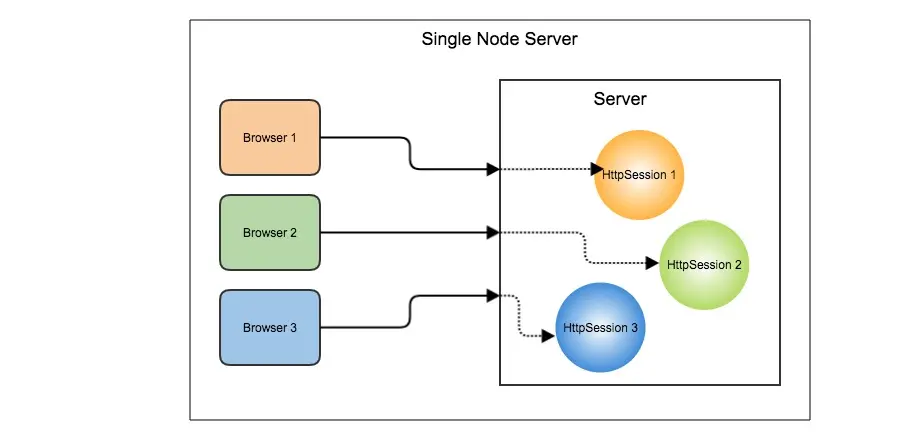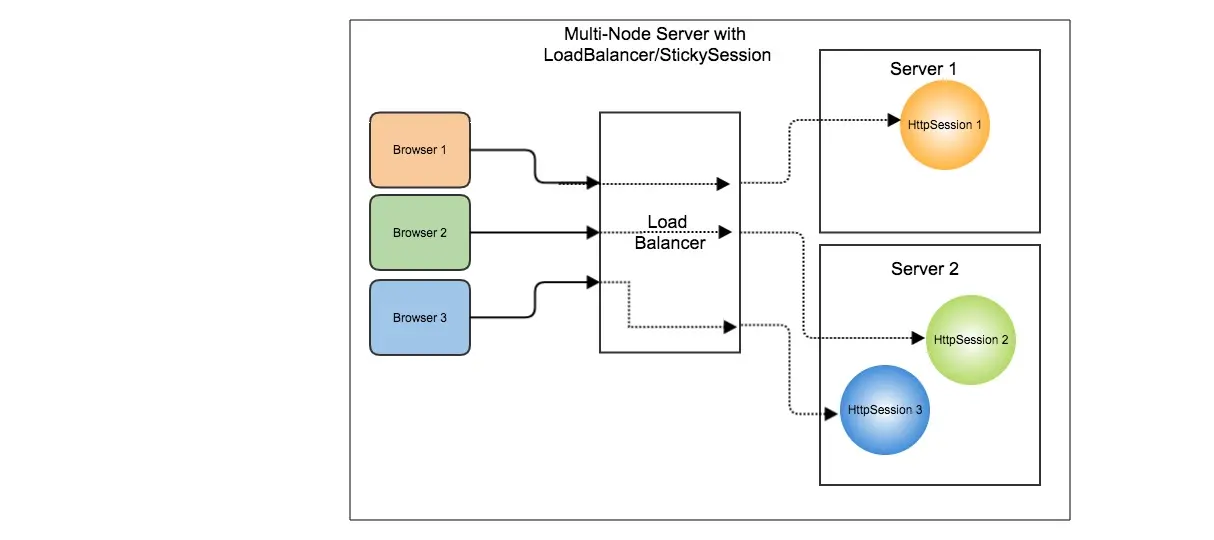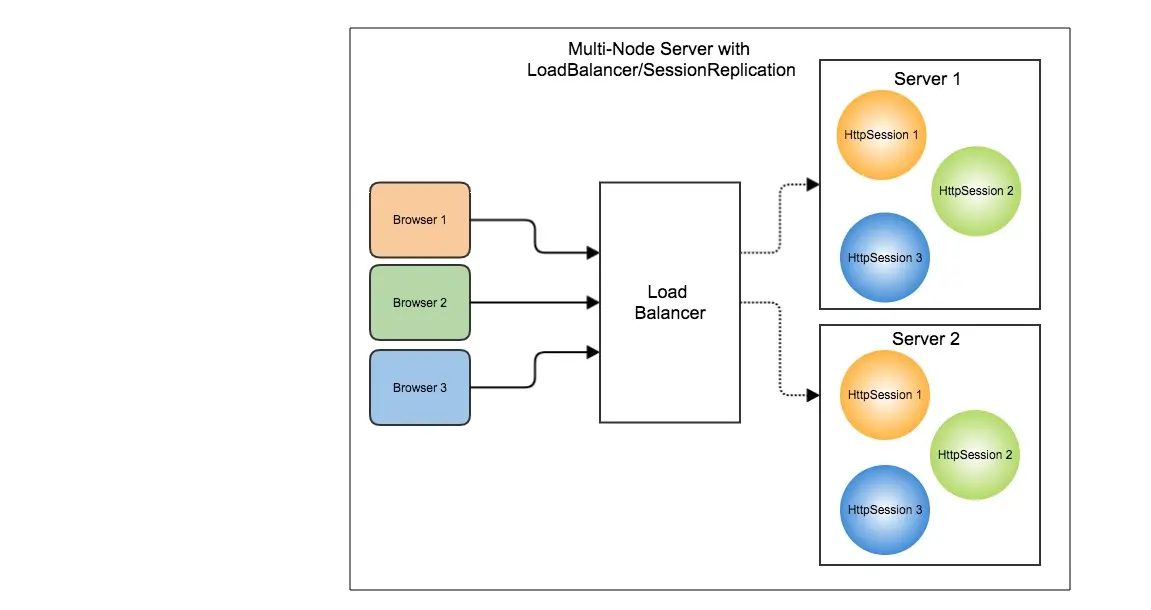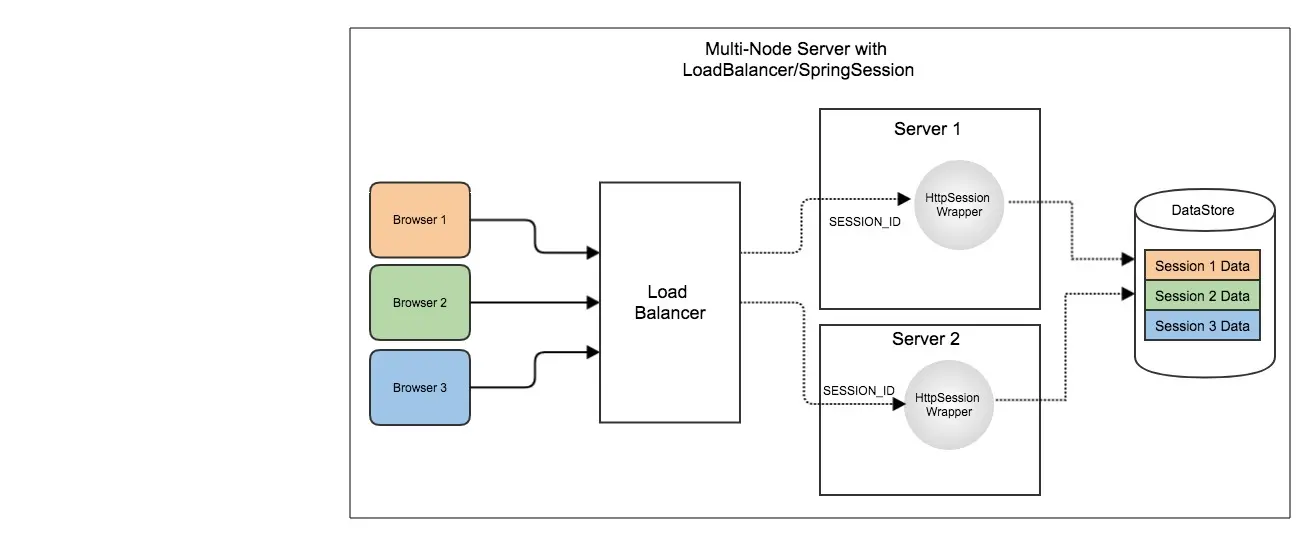Session Management using Spring Session with JDBC DataStore
In web applications, user session management is very crucial for managing user state. In this article, we are going to learn about what are the approaches we have been following to manage user sessions in a clustered environment and how we can use Spring Session to implement it in a much simpler and more scalable way.
Typically in production environments, we will have multiple server nodes with a load balancer in front of them and all the client traffic will be coming through the load balancer to one of the server nodes. So we need some mechanism to make the user session data available to each client in a clustered environment.
Traditionally we have been using the following techniques to manage sessions:
- Single Node Server
- Multi-Node Server with Load Balancer and Sticky sessions
- Multi-Node Server with Load Balancer and Session Replication
- Multi-Node Server with Load Balancer and Session Data in a Persistent DataStore
Let us briefly look at these approaches.
1. Single Node Server
If your application is not a critical service to your business, there won’t be too many users concurrently and some downtime is accepted then we can have Single Node Server deployment as shown below:

In this model, for each browser client, a session object is created on the server (HttpSession in case of Java) and SESSION_ID will be set as a cookie on the browser to identify the session object. But this Single Server Node deployment is not acceptable for most of the applications because if the server goes down the service will be down altogether.
2. Multi-Node Server with Sticky Sessions
In order to make our application highly available and cater more number of users, we can have multiple server nodes behind a load balancer. In the Sticky Sessions approach, we configure our load balancer to route all the requests from the same client to the same node.

In this model, the user session will be created on any one of the server node and all the further requests from that client will be sent to that same node. But the problem with this approach is if a server node goes down then all the user sessions on that server is gone.
3. Multi-Node Server with Session Replication
In this model, the user session data will be replicated on all the server nodes so that any request can be routed to any server node. Even if one node goes down the client request can be served by another node.

But the Session Replication requires better hardware support and involves some server specific configuration.
4. Multi-Node Server with Session Data in a Persistent DataStore
In this model, the user session data will not be held in server’s memory, instead, it will be persisted into a data store and associate it with SESSION_ID.

This solution will be server independent but we may need to write custom code to transparently store the session data in a Persistent datastore whenever a user adds some information to his/her session. This is where Spring Session comes into the picture.
Spring Session
Spring Session is an implementation of approach 4, which is Storing session data in a persistent datastore. Spring Session supports multiple datastores like RDBMS, Redis, HazelCast, MongoDB etc to transparently save use session data. As usual, using Spring Session with Spring Boot is as simple as adding a dependency and configuring few properties. Let us see how we can use Spring Session with JDBC backend store in a Spring Boot application.
You can find the source code for this article at https://github.com/sivaprasadreddy/spring-session-samples
Step 1: Create Spring Boot application
Create a SpringBoot application using the latest version (it is 2.0.0.RC1 as of writing) with Web, Thymeleaf, JPA, H2, Session starters.
By default Session starter will add org.springframework.session:spring-session-core dependency, let us change it to spring-session-jdbc as we are going to use JDBC backend.
<dependency>
<groupId>org.springframework.session</groupId>
<artifactId>spring-session-jdbc</artifactId>
</dependency>
Step 2: Configure Spring Session properties
We can configure type of Spring Session backend data-store using spring.session.store-type property in application.properties.
spring.session.store-type=jdbc
As we are using the H2 In-Memory database, Spring Session creates the following tables required to store session data automatically from the script spring-session-jdbc-2.0.1.RELEASE.jar!/org/springframework/session/jdbc/schema-h2.sql.
CREATE TABLE SPRING_SESSION (
PRIMARY_ID CHAR(36) NOT NULL,
SESSION_ID CHAR(36) NOT NULL,
CREATION_TIME BIGINT NOT NULL,
LAST_ACCESS_TIME BIGINT NOT NULL,
MAX_INACTIVE_INTERVAL INT NOT NULL,
EXPIRY_TIME BIGINT NOT NULL,
PRINCIPAL_NAME VARCHAR(100),
CONSTRAINT SPRING_SESSION_PK PRIMARY KEY (PRIMARY_ID)
);
CREATE UNIQUE INDEX SPRING_SESSION_IX1 ON SPRING_SESSION (SESSION_ID);
CREATE INDEX SPRING_SESSION_IX2 ON SPRING_SESSION (EXPIRY_TIME);
CREATE INDEX SPRING_SESSION_IX3 ON SPRING_SESSION (PRINCIPAL_NAME);
CREATE TABLE SPRING_SESSION_ATTRIBUTES (
SESSION_PRIMARY_ID CHAR(36) NOT NULL,
ATTRIBUTE_NAME VARCHAR(200) NOT NULL,
ATTRIBUTE_BYTES LONGVARBINARY NOT NULL,
CONSTRAINT SPRING_SESSION_ATTRIBUTES_PK PRIMARY KEY (SESSION_PRIMARY_ID, ATTRIBUTE_NAME),
CONSTRAINT SPRING_SESSION_ATTRIBUTES_FK FOREIGN KEY (SESSION_PRIMARY_ID) REFERENCES SPRING_SESSION(PRIMARY_ID) ON DELETE CASCADE
);
CREATE INDEX SPRING_SESSION_ATTRIBUTES_IX1 ON SPRING_SESSION_ATTRIBUTES (SESSION_PRIMARY_ID);
But if we are going to use other RDBMS like MySQL we can configure as follows:
Add MySQL maven dependency.
<dependency>
<groupId>mysql</groupId>
<artifactId>mysql-connector-java</artifactId>
</dependency>
Configure datasource properties for MySQL:
spring.datasource.driver-class-name=com.mysql.jdbc.Driver
spring.datasource.url=jdbc:mysql://localhost:3306/demo
spring.datasource.username=root
spring.datasource.password=admin
With this property, Spring Session will try to create tables using the script classpath:org/springframework/session/jdbc/schema-@@platform@@.sql, so in our case, it will use schema-mysql.sql.
Step 3: Add data to HttpSession
Now create a simple form in src/main/resources/templates/index.html.
<!DOCTYPE html>
<html lang="en" xmlns:th="http://www.thymeleaf.org">
<head>
<meta charset="UTF-8">
<title>Spring Session + JDBC Demo</title>
</head>
<body>
<div>
<form th:action="@{/messages}" method="post">
<textarea name="msg" cols="40" rows="4"></textarea>
<input type="submit" value="Save"/>
</form>
</div>
<div>
<h2>Messages</h2>
<ul th:each="m : ${messages}">
<li th:text="${m}">msg</li>
</ul>
</div>
</body>
</html>
Let us implement a Controller to add messages to HttpSession and display them.
import org.springframework.stereotype.Controller;
import org.springframework.ui.Model;
import org.springframework.web.bind.annotation.GetMapping;
import org.springframework.web.bind.annotation.PostMapping;
import org.springframework.web.bind.annotation.RequestParam;
import javax.servlet.http.HttpServletRequest;
import javax.servlet.http.HttpSession;
import java.util.*;
@Controller
public class MessagesController
{
@GetMapping("/")
public String index(Model model, HttpSession session) {
List<String> msgs = (List<String>) session.getAttribute("MY_MESSAGES");
if(msgs == null) {
msgs = new ArrayList<>();
}
model.addAttribute("messages", msgs);
return "index";
}
@PostMapping("/messages")
public String saveMessage(@RequestParam("msg") String msg, HttpServletRequest request)
{
List<String> msgs = (List<String>) request.getSession().getAttribute("MY_MESSAGES");
if(msgs == null) {
msgs = new ArrayList<>();
request.getSession().setAttribute("MY_MESSAGES", msgs);
}
msgs.add(msg);
return "redirect:/";
}
}
Now you can start the application and add some messages to HttpSession and you can see the rows in SPRING_SESSION, SPRING_SESSION_ATTRIBUTES tables. By default, Spring Session converts the objects that we are trying to add to HttpSession into ByteArray and store it in the table.
Spring Session with Spring Security
Spring Session seamlessly integrates with Spring Security because of SpringBoot’s auto-configuration. Let us add Spring Security to our application.
<dependency>
<groupId>org.springframework.boot</groupId>
<artifactId>spring-boot-starter-security</artifactId>
</dependency>
Add a default user credentials in application.properties as follows:
spring.security.user.name=admin
spring.security.user.password=secret
Now if you try to access http://localhost:8080/ you will be redirected to auto-generated Login page. Once you login and see the data in SPRING_SESSION table you can see that login username is stored in PRINCIPAL_NAME column.
How does Spring Session work?
Spring Session provides implementations for HttpServletRequest and HttpSession which are SessionRepositoryRequestWrapper and HttpSessionWrapper. Spring Session provides SessionRepositoryFilter to intercept all the requests and wrap the HttpServletRequest in SessionRepositoryRequestWrapper.
In SessionRepositoryRequestWrapper.getSession(boolean) is overriden to return HttpSessionWrapper object instead of default server implementation of HttpSession. The HttpSessionWrapper uses SessionRepository to persist session information in a datastore.
The SessionRepository interface has various methods to manage sessions.
public interface SessionRepository<S extends Session>
{
S createSession();
void save(S session);
S findById(String id);
void deleteById(String id);
}
This SessionRepository interface is implemented by various classes based on the type of backend we are using. In our case, we are using JdbcOperationsSessionRepository provided by spring-session-jdbc.
Conclusion
As you might have already observed we can manage user sessions effectively by using Spring Session with very minimal configuration because of Spring Boot auto-configuration. If for any reason we want to change the backend from JDBC to Redis or Hazelcast etc it is only simple configuration change as we are not directly depending on any Spring Session classes.
You can find the source code for this article at https://github.com/sivaprasadreddy/spring-session-samples
Related content
- MicroServices - Part 6 : Distributed Tracing with Spring Cloud Sleuth and Zipkin
- MicroServices - Part 5 : Spring Cloud Zuul Proxy as API Gateway
- MicroServices - Part 4 : Spring Cloud Circuit Breaker using Netflix Hystrix
- MicroServices - Part 3 : Spring Cloud Service Registry and Discovery
- MicroServices - Part 2 : Configuration Management with Spring Cloud Config and Vault